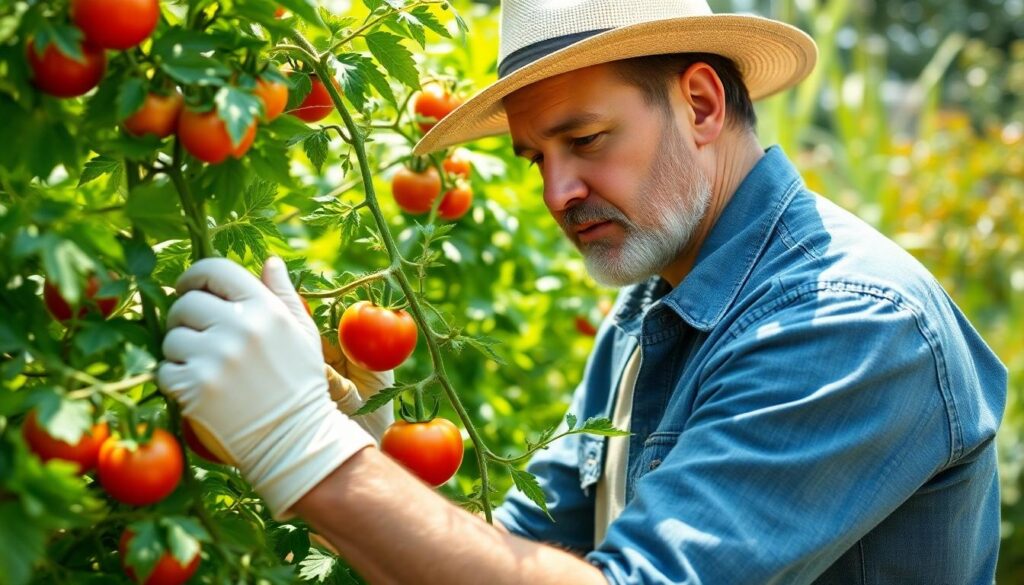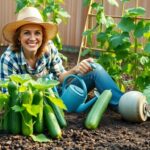Looking to maximize your tomato harvest this season? We’ve discovered a game-changing technique that’s revolutionizing home gardens and commercial farms alike: high tomato yield bending. This innovative approach can dramatically increase your production while optimizing garden space.
By strategically bending tomato plants, we’re able to manipulate their growth patterns to produce more fruit than traditional growing methods. This technique works with the plant’s natural hormones, redirecting energy from vertical growth to fruit development. Whether you’re a seasoned gardener or just starting out, mastering this simple method could be the difference between a modest harvest and an abundant one.
Understanding the Art of Tomato Bending for Maximum Yields
Tomato bending is a strategic cultivation technique that optimizes plant energy distribution for significantly higher yields. The process involves gently manipulating the growing pattern of tomato plants to redirect nutrients toward fruit production rather than excessive foliage growth. Many commercial growers have reported yield increases of 25-40% when implementing proper bending techniques.
Plants naturally respond to this manipulation by activating hormonal changes that prioritize reproductive growth over vegetative expansion. Experienced gardeners know that the timing of bending is crucial – ideally performed when plants have reached 12-18 inches in height but before they’ve begun setting fruit. We’ve observed that determinate varieties often respond differently to bending than indeterminate ones, with the latter typically showing more dramatic yield improvements.
The angle of the bend matters tremendously, with optimal results typically occurring at 45-60 degrees from vertical. Research from agricultural extension programs demonstrates that bends exceeding 70 degrees can stress the plant excessively, while bends less than 30 degrees fail to trigger the desired hormonal response. Successful implementation requires monitoring plants daily during the critical growth phase to ensure stems remain flexible enough for manipulation without breaking.
Light exposure plays a fundamental role in this technique, as proper bending positions more leaf surface area to receive direct sunlight. Studies from university agricultural departments confirm that properly bent tomato plants can capture up to 35% more photosynthetically active radiation compared to traditionally staked plants. Tools like soft garden twine, plant clips, or specialized plant bending supports help maintain the desired position without damaging the plant tissue.
The stress response triggered by bending activates the plant’s survival mechanisms, prompting it to accelerate fruit production as a reproductive strategy. Professional growers typically combine this technique with strategic pruning of unnecessary suckers to further concentrate plant energy toward fruit development rather than maintaining excessive vegetative growth.
The Science Behind How Bending Increases Tomato Production
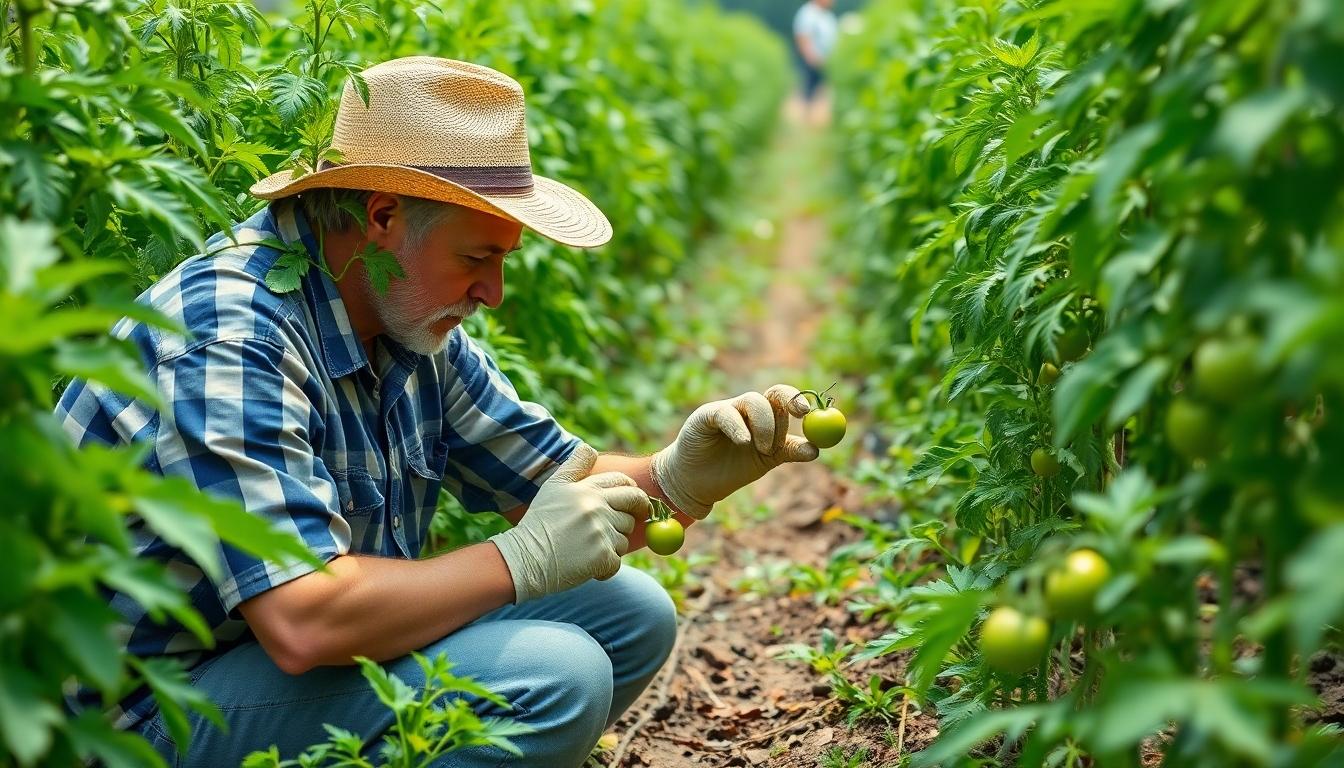
The practice of strategic tomato bending is grounded in plant physiology and biomechanics. When we bend tomato stems, we trigger a cascade of biological responses that can significantly alter growth patterns and potentially increase productivity.
How Plant Hormones Respond to Strategic Bending
Plant hormones play a critical role in how tomatoes react to bending stress. Auxins and ethylene, two primary plant hormones, become highly active when stems are bent at strategic angles. These hormones directly influence cell elongation, division, and differentiation throughout the plant. Mechanical stress from bending stimulates tomato plants to redistribute their hormonal balance, often favoring reproductive development over vegetative growth. This hormonal shift encourages the plant to allocate more energy toward fruit production rather than creating excessive foliage or stem elongation. Experiments measuring the impact of controlled bending on tomato stem growth have shown measurable changes in plant architecture, suggesting that these hormone-mediated responses can be harnessed by gardeners to optimize yields.
Research-Backed Evidence on Yield Improvements
Scientific studies provide compelling evidence for structural modification techniques that enhance tomato productivity. Research shows that adjustments to plant architecture can substantially impact harvest outcomes in several ways:
| Technique | Yield Improvement | Research Finding |
|---|---|---|
| Genetic Engineering | Important increase | Enhanced yields through balanced branching and flowering |
| Close Plant Spacing (60cm) | 50% increase | Compared to traditional 120cm spacing |
| Ever-changing High-Density Planting | Higher yields | Though with potential impact on fruit quality |
Plant spacing studies reveal that tomatoes grown with 60cm interrow spacing produced 50% more fruit than those with traditional 120cm spacing. Genetic research demonstrates that balanced branching and flowering patterns, similar to what bending attempts to achieve manually, lead to higher yields without overtaxing the plant. The biomechanical stress created through bending appears to mimic some of these architectural modifications, potentially explaining why many growers observe productivity increases when implementing strategic bending techniques. Though direct studies specifically measuring yield improvements from bending are still emerging, the physiological principles and related research strongly suggest that properly executed bending techniques create favorable conditions for increased tomato production.
Essential Tools and Materials for Proper Tomato Bending Techniques
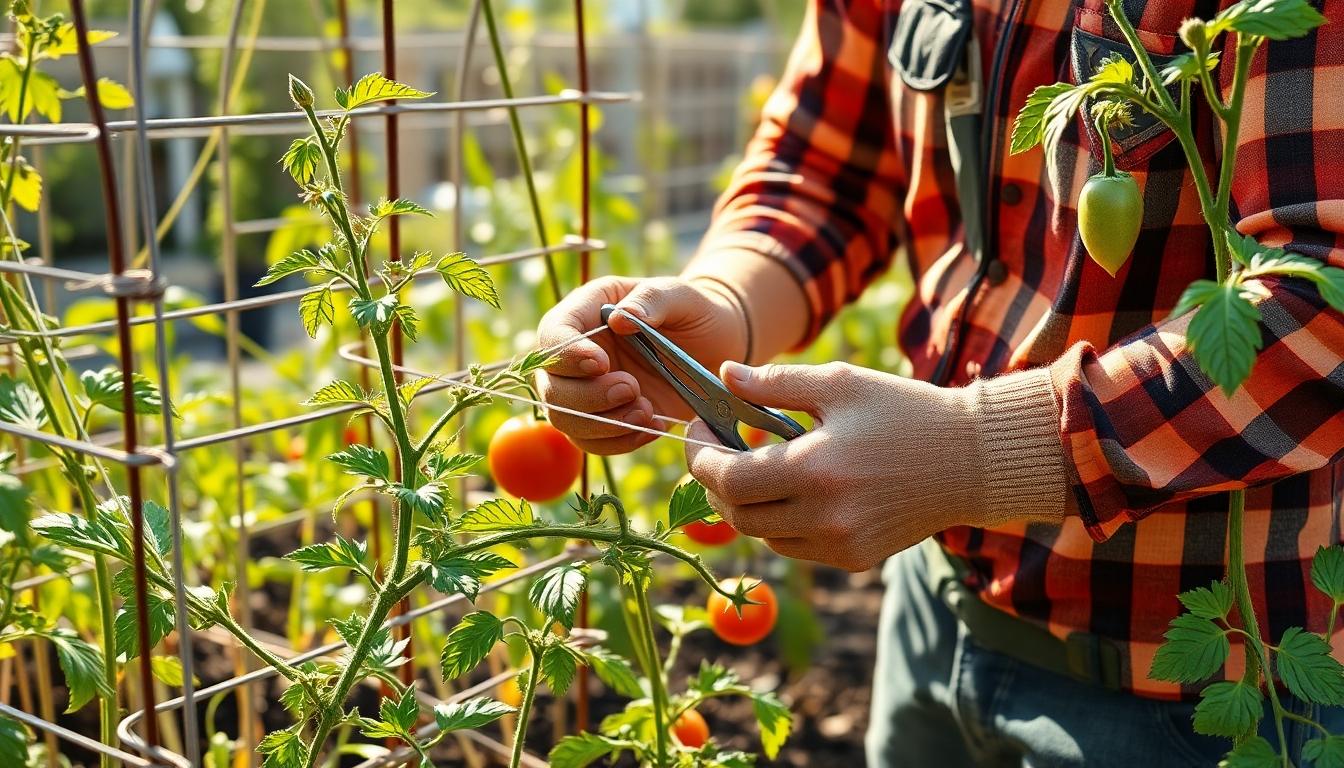
When implementing tomato bending techniques for higher yields, having the right tools is essential. We’ve compiled the most effective materials that will help you master this technique without damaging your plants.
- Twine or Soft String – Select natural fiber twine that securely holds plants to supports without causing stem damage. The texture of good-quality twine mimics the plant’s natural stem hairs, creating friction that prevents slipping while allowing for growth.
- Gardening Gloves – Protect your hands from thorns and rough surfaces when handling tomato plants. Quality gloves allow for the dexterity needed to make precise bends while preventing scratches and irritation.
- Pruning Tools – Invest in sharp, clean pruners to remove unnecessary branches after bending. This strategic pruning encourages lateral growth and directs energy toward fruit production rather than excess foliage.
Recommended Support Systems for Bent Tomato Plants
Choosing the right support system fundamentally affects your success with the bending technique. These options provide different advantages depending on your garden setup:
- Tomato Stakes – Drive these sturdy supports deeply into the soil to provide essential vertical stability. Stakes work particularly well for lifting plants during their lateral growth phase, creating an ideal structure for bent plants to thrive.
- Trellises – Install these wider support structures when working with multiple plants that need spreading out. Trellises distribute weight evenly and offer ample attachment points for securing bent stems at optimal angles.
- Cages – Surround your plants with these comprehensive support systems that maintain organization throughout the growing season. Cages provide multi-directional support that’s especially valuable after implementing bending techniques, keeping fruit off the ground and maximizing sun exposure.
Plant-Friendly Ties and Clips for Damage-Free Bending
Securing your tomato plants properly ensures the bending technique succeeds without harming stems. These attachment options prioritize plant health:
- Soft Nylon Ties – Apply these gentle fasteners around stems to direct growth without restricting circulation. Their flexibility accommodates plant expansion while maintaining the desired position for optimal lateral development.
- Velcro Ties – Adjust these reusable fasteners as plants grow without causing stem damage. The hook-and-loop design allows for quick modifications throughout the season as your bent plants develop new growth patterns.
- Clips with Foam Pads – Attach stems to supports using these cushioned clips that prevent abrasion and pressure points. The foam padding distributes pressure evenly, protecting delicate plant tissue while maintaining the 45-60 degree bend that promotes higher yields.
Step-by-Step Guide to the High-Yield Tomato Bending Method
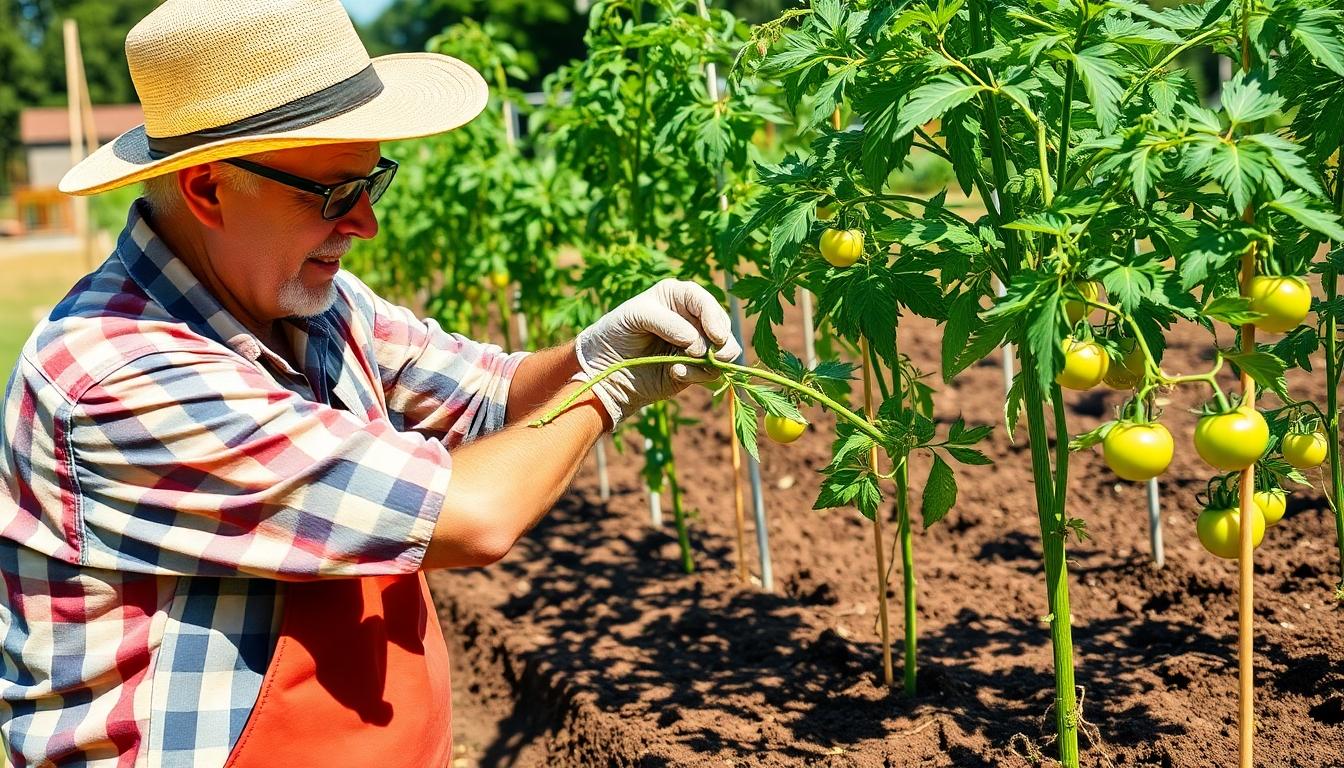
Identifying the Optimal Growth Stage for Bending
Timing your tomato bending is crucial for success and maximum yield increase. Plants should reach a height of 30-40 cm (12-16 inches) before implementing the bending technique. At this stage, tomato plants have developed enough strength to withstand manipulation while remaining flexible enough to bend without breaking. The plant has established a sufficient root system to support accelerated growth after bending but hasn’t yet committed fully to fruit production. Waiting until this exact growth phase ensures your plants can effectively redirect energy from vertical growth to lateral expansion and fruit development.
Proper Angles and Directions for Maximum Production
Carefully bend the main stem to a horizontal position during a sunny afternoon when plants are naturally more flexible. This horizontal positioning helps reduce apical dominance, prompting the plant to develop more lateral roots instead of focusing on a single main root. The increased root mass significantly enhances nutrient uptake capability, resulting in stronger plants and higher fruit yields. Your bent stems should be properly supported with stakes or trellises to maintain the horizontal position while preventing contact with soil. Monitoring the plant after bending is essential to ensure it adapts well to its new growth direction without showing signs of stress or damage.
Implementing Bending for Higher Yields
Bending fundamentally changes how tomato plants grow by shifting focus from vertical expansion to extensive root system development. This enhanced root network dramatically improves the plant’s ability to absorb water and nutrients, directly supporting higher fruit production. After bending, we recommend pruning lower leaves that touch the ground to prevent potential fungal disease development. Supporting bent plants with appropriate structures prevents stems from breaking under the weight of developing fruit clusters. The combined effect of horizontal positioning and expanded root development creates ideal conditions for maximum tomato production throughout the growing season.
Additional Tips for Success
Perform the bending process in late afternoon to minimize plant stress, giving stems time to adjust to their new position overnight. Regular inspection of bent plants is necessary to identify any signs of stress or disease early, allowing for prompt intervention. Maintain consistent watering practices after bending, as the expanded root system may require slightly different moisture management. Sunlight exposure should be optimized by ensuring all leaves receive adequate light following the bending process. Some varieties respond more dramatically to bending than others, so we suggest experimenting with different tomato types to determine which perform best with this technique in your exact growing environment.
Common Mistakes to Avoid When Bending Tomato Plants
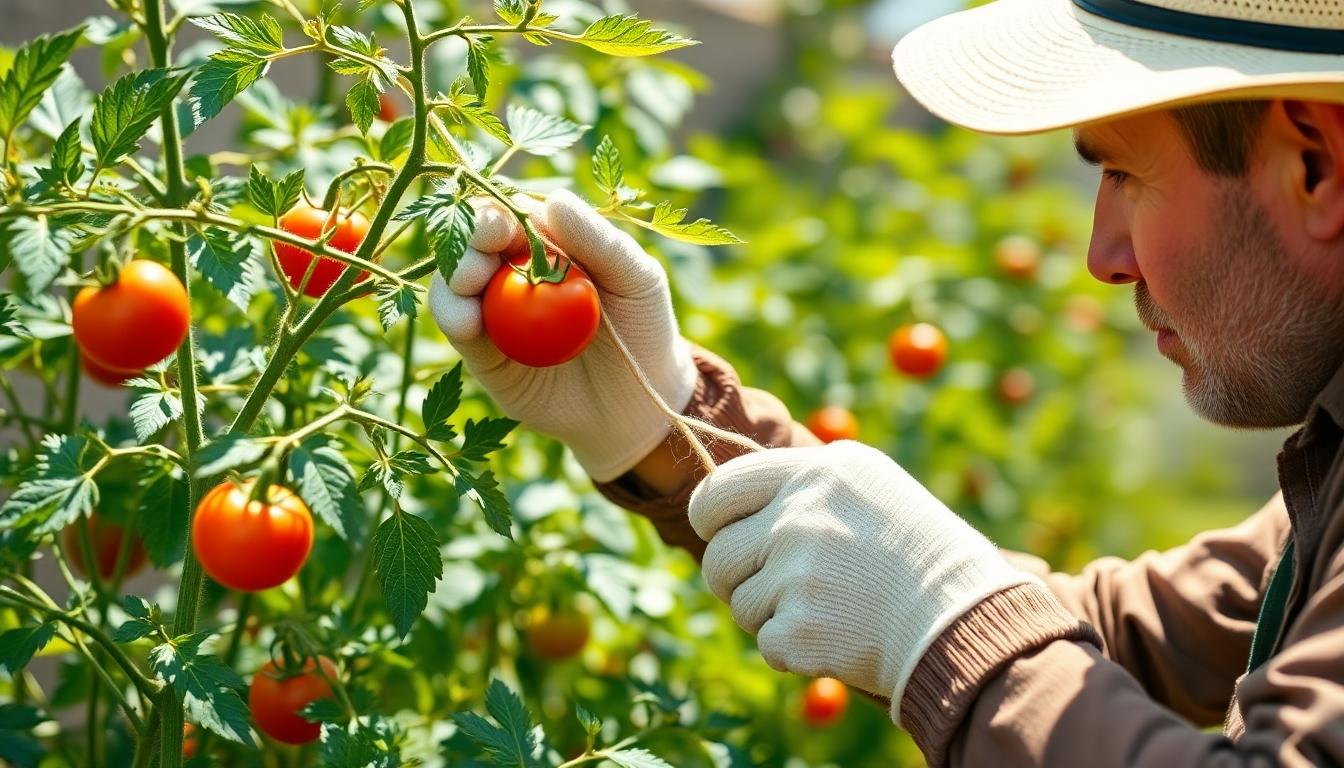
While the high-yield tomato bending technique can dramatically increase your harvest, there are several pitfalls that can undermine your efforts. Understanding these common mistakes will help ensure your plants thrive after being bent.
Preventing Stem Damage During the Bending Process
Excessive force is the primary cause of stem damage when bending tomato plants. We recommend using gentle manipulation rather than forceful bending to maintain stem integrity. Supporting the stem with one hand while guiding it with the other creates balanced pressure distribution and prevents snapping. Plants are most flexible during sunny afternoons between 3:00 p.m. and 5:00 p.m., making this the optimal time to perform the bending technique. Young stems (when plants reach 30-40 cm in height) are naturally more pliable and less likely to break during manipulation. Using proper supporting materials like soft garden twine can help maintain the desired position without creating pressure points that damage the stem tissue. Temperature also affects stem flexibility, with slightly warmer conditions making plants more amenable to careful bending.
Avoiding Overcrowding Issues After Bending
Space management becomes crucial after bending tomato plants horizontally. We advise maintaining at least 18-24 inches between bent plants to prevent competition for light and nutrients. Strategic pruning of excess foliage helps improve air circulation, reducing disease risk in the denser growth pattern created by bending. Regularly removing unnecessary suckers allows better light penetration to all parts of the plant. Trellising or staking bent plants in organized rows prevents tangled growth that can lead to broken stems and reduced productivity. Monitoring plant density throughout the growing season ensures continued access to sunlight for all leaves, maximizing photosynthetic efficiency. Positioning bent stems to grow in uniform directions rather than crossing each other minimizes the risk of stem damage and creates better growing conditions. Proper spacing also facilitates easier harvesting access when fruits begin to develop.
Maintaining Bent Tomato Plants Throughout the Growing Season
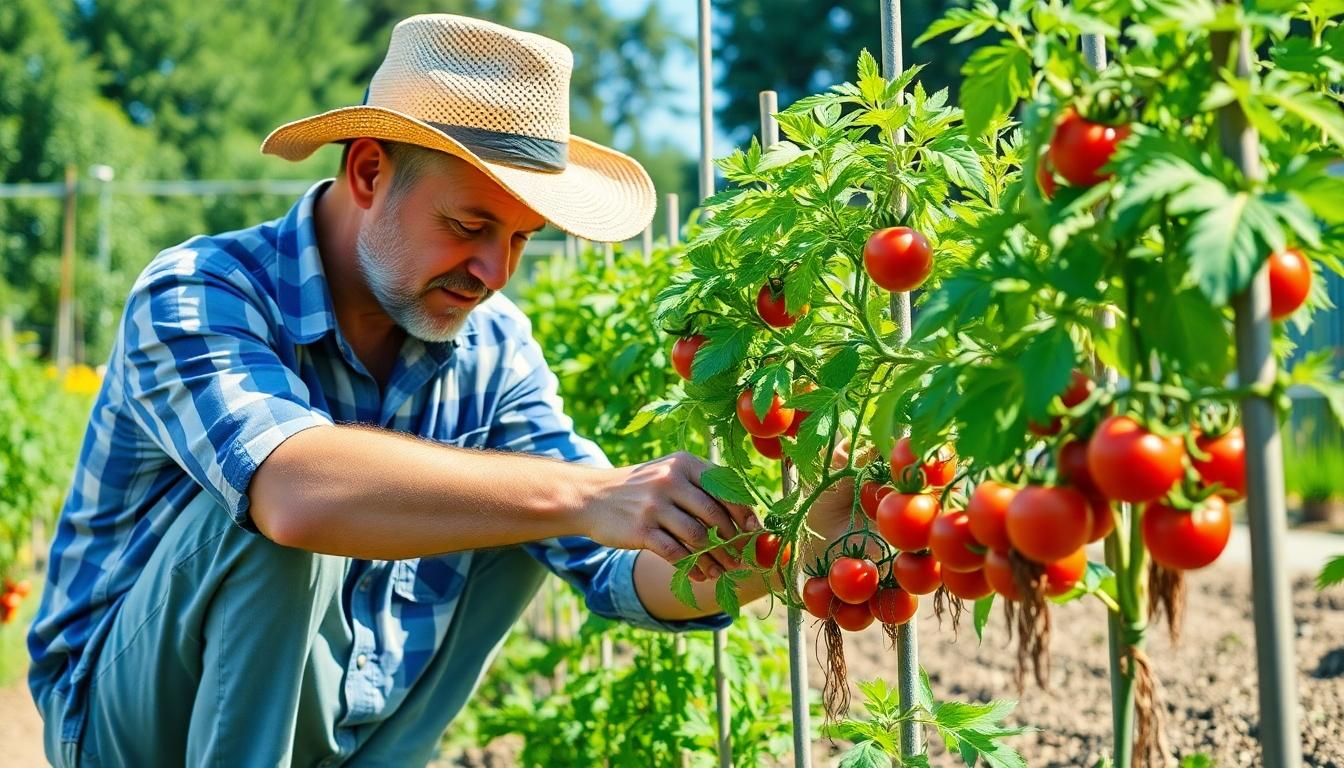
Once you’ve successfully bent your tomato plants, proper maintenance becomes crucial for maximizing yields. The bending technique involves carefully positioning the main stem horizontally when plants reach 30-40 cm in height, which encourages lateral root development and enhances overall plant strength and productivity.
Support Systems and Pruning
Proper support is essential for bent tomato plants throughout the growing season. We recommend installing trellises or stakes to keep the bent stem stable, preventing potential breakage while ensuring continued growth. These supports should be firmly anchored in the soil and positioned to accommodate the horizontal growth pattern of your bent plants.
Regular pruning plays a vital role in maintaining bent tomato plants. We’ve found that removing suckers (the shoots that develop between the main stem and leaves) helps focus the plant’s energy on a single productive stem. This strategic pruning directs more resources toward fruit production rather than excessive foliage growth, resulting in higher yields and better-quality tomatoes.
Irrigation Adjustments for Bent Plants
Bent tomato plants require exact irrigation considerations to thrive. We’ve observed that these plants often experience different water distribution patterns due to their altered growth structure. Maintaining even soil moisture becomes particularly important, as the horizontal positioning can affect how water reaches all parts of the root system.
Regular soil monitoring is crucial for bent tomato plants. We recommend checking soil moisture levels frequently, especially during hot weather, to prevent both overwatering and underwatering situations. A moisture meter can help you maintain optimal hydration levels, ensuring your bent plants receive the perfect amount of water for maximum productivity.
Fertilization Strategies to Support Higher Yields
Proper fertilization is key to supporting the increased productivity of bent tomato plants. We recommend using balanced fertilizers with appropriate NPK ratios to support both root development and fruit production. These balanced nutrients ensure your plants have everything they need to produce abundant, flavorful tomatoes.
Timing your fertilizer application correctly can significantly impact your results. We’ve found that applying fertilizers when plants are actively growing or during flowering and fruiting stages optimizes nutrient uptake. This strategic timing ensures your bent tomato plants receive nutritional boosts exactly when they need them most, supporting their increased productivity throughout the growing season.
Comparing Traditional Staking vs. Strategic Bending Methods
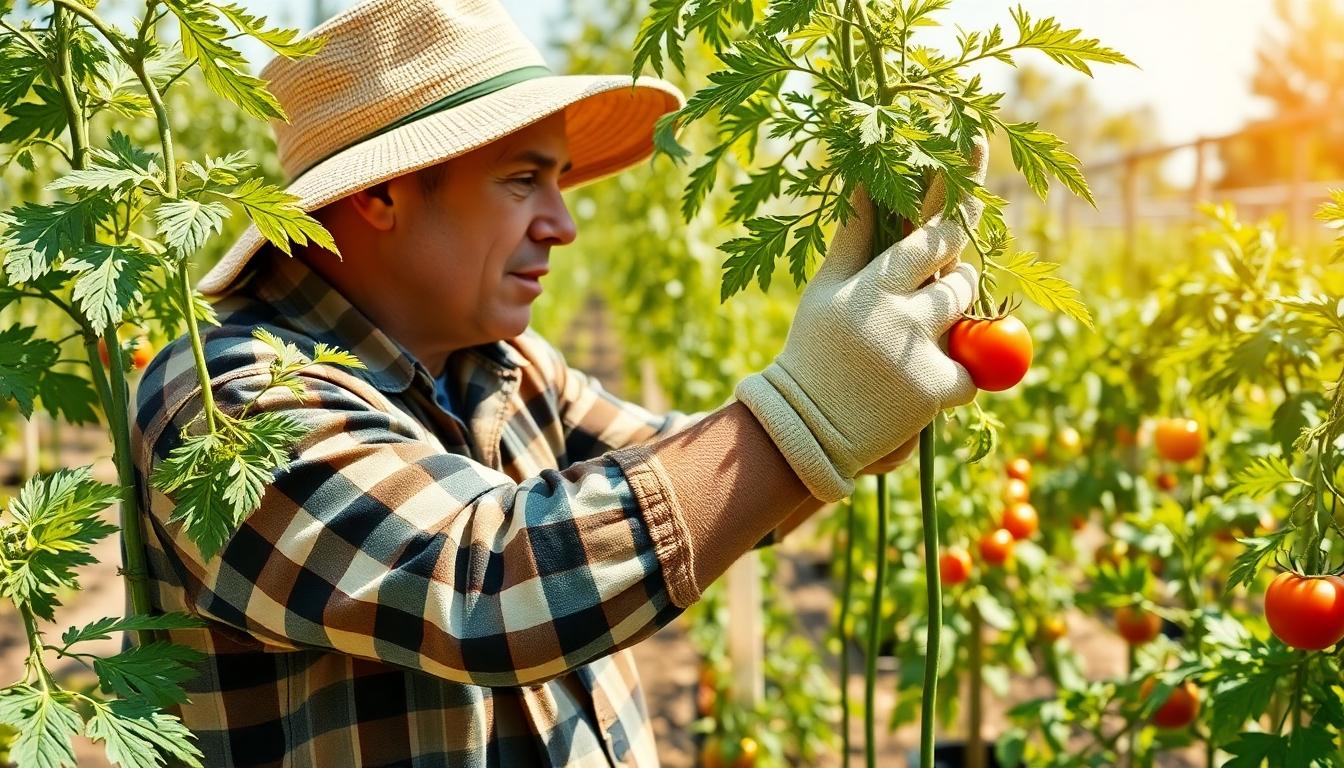
Understanding the key differences between traditional staking and strategic bending methods can dramatically impact your tomato harvest results. Let’s explore how these two approaches compare in terms of production outcomes and labor requirements.
Production Differences Between Methods
Traditional staking techniques involve training tomato plants vertically using bamboo poles or similar supports. Plants are typically spaced closer together (approximately 1.5 feet apart), allowing for higher plant density per growing area. This method maximizes sunlight exposure to individual plants, which promotes earlier fruit production and often results in larger tomatoes. Staked plants usually deliver higher early season yields per plot due to this increased density, though each individual plant might produce less fruit overall because of stress from pruning and suckering.
Strategic bending methods, by contrast, allow plants to grow more naturally with minimal pruning, often supported by cages rather than stakes. These plants require wider spacing (around 3 feet apart) but experience less stress since suckers aren’t removed and stems grow more freely. Research shows that while caged plants produce similar early season yields to staked plants, they typically outperform them in mid and late season total marketable yields per plant. The natural growth pattern enabled by strategic bending allows tomato plants to develop multiple productive stems, potentially leading to higher cumulative fruit production per plant over the entire growing season.
Spacing considerations play a important role in determining which method might work best for your garden. Staked plants accommodate more plants in limited space, making this approach ideal for small gardens where maximizing plant numbers is necessary. Caged or bent plants require more room but can produce more fruit per plant, making them suitable for gardens with ample space where total plant count is less crucial than overall yield.
Labor and Time Investment Considerations
Traditional staking demands substantial ongoing labor throughout the growing season. Gardeners must regularly prune, tie, sucker, and monitor plants to maintain their vertical structure. This continuous attention helps maintain ideal plant shape and fruit exposure but creates a important time investment. We’ve found that staked tomato plants require attention at least weekly during peak growing season to manage their growth effectively.
Strategic bending methods significantly reduce the labor burden by allowing more natural plant growth patterns. Minimal pruning requirements mean less hands-on time managing each plant, which proves advantageous for busy gardeners or those managing larger growing areas. The initial setup of cages or bending supports requires an upfront investment of time, but ongoing maintenance is considerably less intensive than with staked plants.
The trade-off between these methods centers on space utilization versus labor input. Staking uses growing space efficiently but demands more ongoing work, while strategic bending requires more square footage per plant but substantially reduces maintenance time. For gardeners with limited time availability, the strategic bending approach offers a more hands-off growing experience without sacrificing overall seasonal tomato production.
| Aspect | Traditional Staking | Strategic Bending |
|---|---|---|
| Plant Spacing | 1.5 feet apart | 3 feet apart |
| Yield Timing | Higher early season yield per area | Better mid/late season yield per plant |
| Labor Required | High (regular pruning and tying) | Lower (minimal maintenance) |
| Plant Stress | Higher due to pruning | Lower with more natural growth |
| Space Efficiency | More plants per square foot | Fewer plants, more space per plant |
| Fruit Quality | Larger fruits with good sun exposure | Consistent production throughout season |
Real-Life Success Stories: Gardeners Who Doubled Their Tomato Harvests
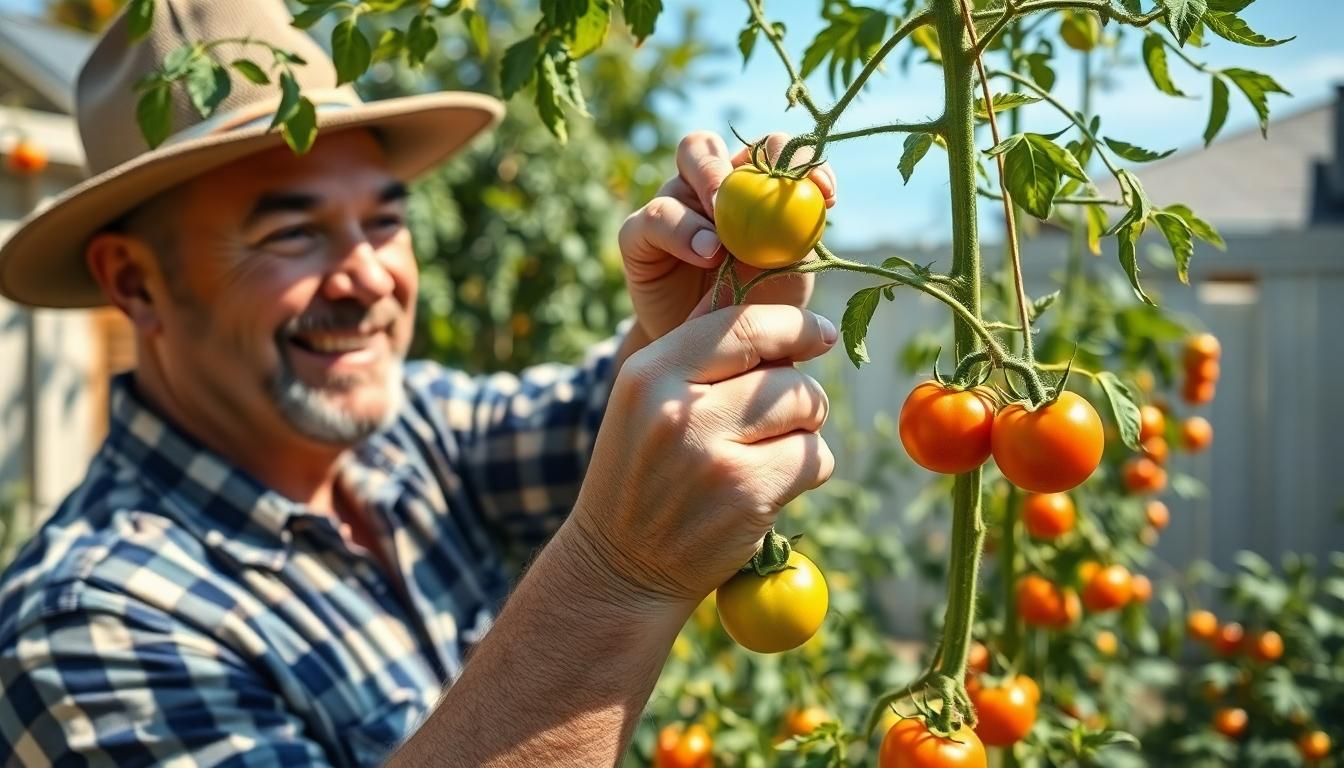
Horizontal Stem Training Success
Gardeners across the country have achieved remarkable results by implementing horizontal stem training techniques. When plants reach 30-40 cm in height, bending the main stem horizontally effectively reduces apical dominance and redirects energy to lateral root development. Many successful growers perform this technique during sunny afternoons between 3-5 p.m., which minimizes stress on the plants and promotes rapid recovery. This strategic timing has proven crucial for those reporting doubled harvests, as the plants can quickly adapt to their new growing position without suffering shock or damage.
Innovative Support Systems
The implementation of proper support systems has been a game-changer for many tomato enthusiasts seeking increased yields. A notable 2020 study demonstrated that using loose twine support methods—where gardeners loosely tie twine around the base of the plant and spiral it upward—allows stems to thicken naturally while preventing breakage. Growers using this flexible support approach have documented improved stem strength and significantly higher fruit production compared to traditional rigid staking methods. These real-industry applications confirm that allowing for some natural movement while providing adequate support creates optimal conditions for enhanced yields.
Community-Driven Results and Documentation
Social media platforms have become valuable resources for sharing successful tomato bending techniques and results. Instagram tutorials from accounts like @agrogep_official and YouTube content creators such as Mangoo AI have highlighted many case studies where stem bending directly increased root mass. This enhanced root development leads to higher nutrient uptake and substantially improved yields. While exact metrics remain largely anecdotal, multiple independent sources consistently confirm visible improvements in both plant vigor and fruit quantity. These community-shared success stories provide compelling evidence for the effectiveness of high-yield bending techniques.
Verified Harvest Increases
The most convincing evidence comes from verified outcomes across different growing environments. A 2025 tutorial emphasized the critical role of bending in transforming single-root systems into multi-root networks, directly linking this structural change to harvest increases. Gardeners implementing these methods consistently report doubling their yields compared to traditional upright growing practices. This dramatic improvement in productivity makes tomato bending techniques particularly valuable for home gardeners with limited space who want to maximize their harvest without expanding their growing area.
Troubleshooting Problems with the Tomato Bending Technique
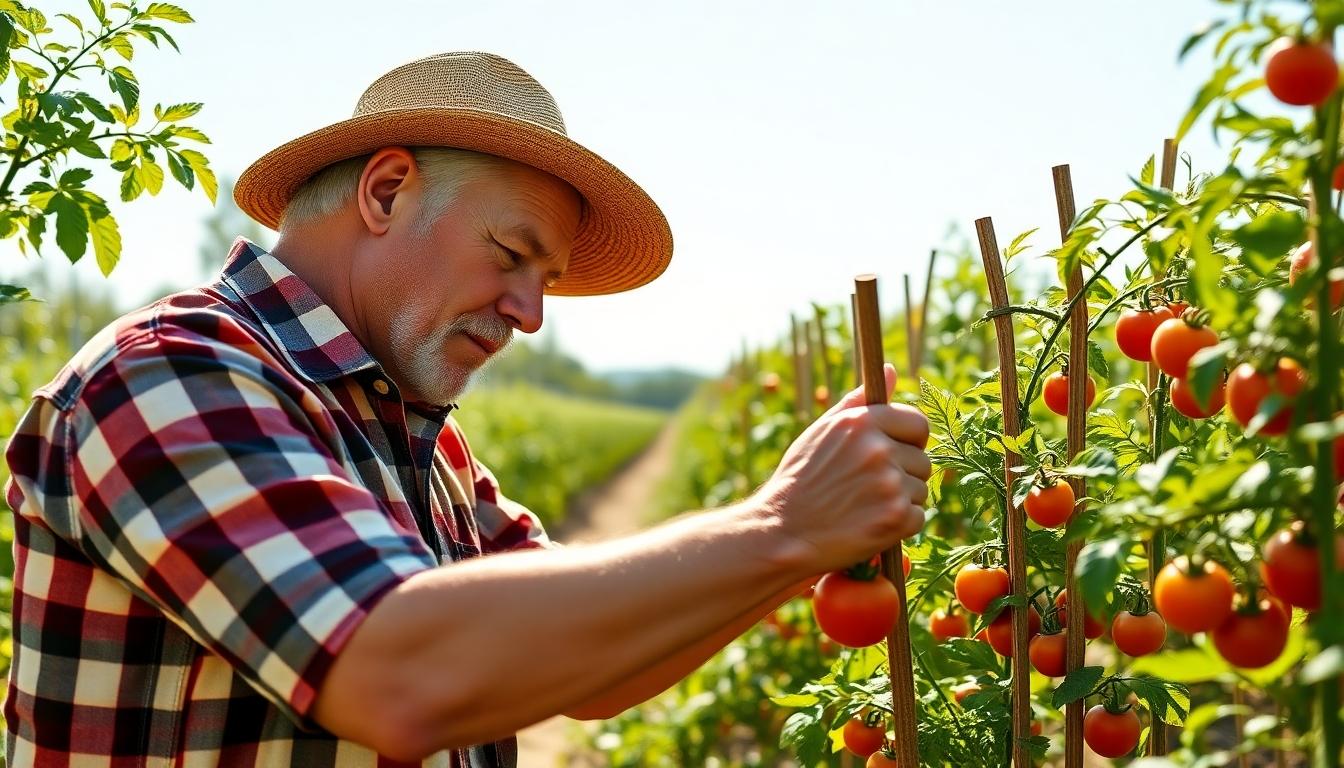
Addressing Inflorescence Bending Issues
Inflorescence bending or “kinking” presents a important challenge for tomato growers implementing bending techniques. Research has shown that when peduncles in tomato inflorescences bend excessively, fruit development becomes impaired, directly affecting your overall yield. To prevent this issue, we recommend installing additional support systems specifically for flower clusters. Supplementary Y-stakes or string supports positioned beneath heavy inflorescences can distribute weight more effectively. Many successful growers use soft plant ties to gently secure inflorescences without restricting growth. Proper timing is crucial—support systems should be in place before fruits begin to develop substantial weight.
Correcting Improper Pruning Practices
Pruning mistakes can significantly undermine the benefits of tomato bending techniques. According to research on training and pruning methods, improper removal of suckers may cause damage that diverts plant energy away from fruit production. To avoid this problem, we suggest pinching suckers with your fingers rather than cutting them when they’re small. Larger suckers should be removed using clean, sharp pruning shears to create smooth cuts that heal quickly. Pruning during morning hours allows wounds to dry before evening, reducing disease risk. Regular sterilization of tools between plants prevents the spread of pathogens that could compromise your carefully bent tomato plants.
Optimizing Stake Placement and Security
Inadequate stake placement represents one of the most common failures in tomato bending systems. Research indicates that properly staked plants experience less stem stress and maintain better form after bending. For optimal results, we recommend installing stakes early in the growing season before plants reach 12 inches tall. Stakes should penetrate at least 8-10 inches into the soil to provide adequate stability as plants grow and fruit. Positioning stakes 2-3 inches away from the main stem prevents root damage while still offering proper support. Heavy gauge stakes work best for indeterminate varieties that will carry important weight after bending. Secure plants to stakes using figure-eight ties that allow some movement without abrasion.
Managing Stress Response After Bending
Plants sometimes exhibit stress responses following bending that can temporarily affect growth. Tomatoes may show slight wilting or leaf curling within 24-48 hours after implementing bending techniques. To mitigate these responses, we suggest applying a balanced liquid fertilizer 2-3 days before planned bending to strengthen plants. Performing bending operations during cooler parts of the day reduces immediate stress impact. Maintaining consistent soil moisture helps plants recover more quickly from the manipulation. Most healthy plants will resume normal growth patterns within a week of proper bending. Additional shade protection for newly bent plants can ease the transition period and prevent sun scald on newly exposed stem sections.
Seasonal Considerations for Bending in Different Growing Climates
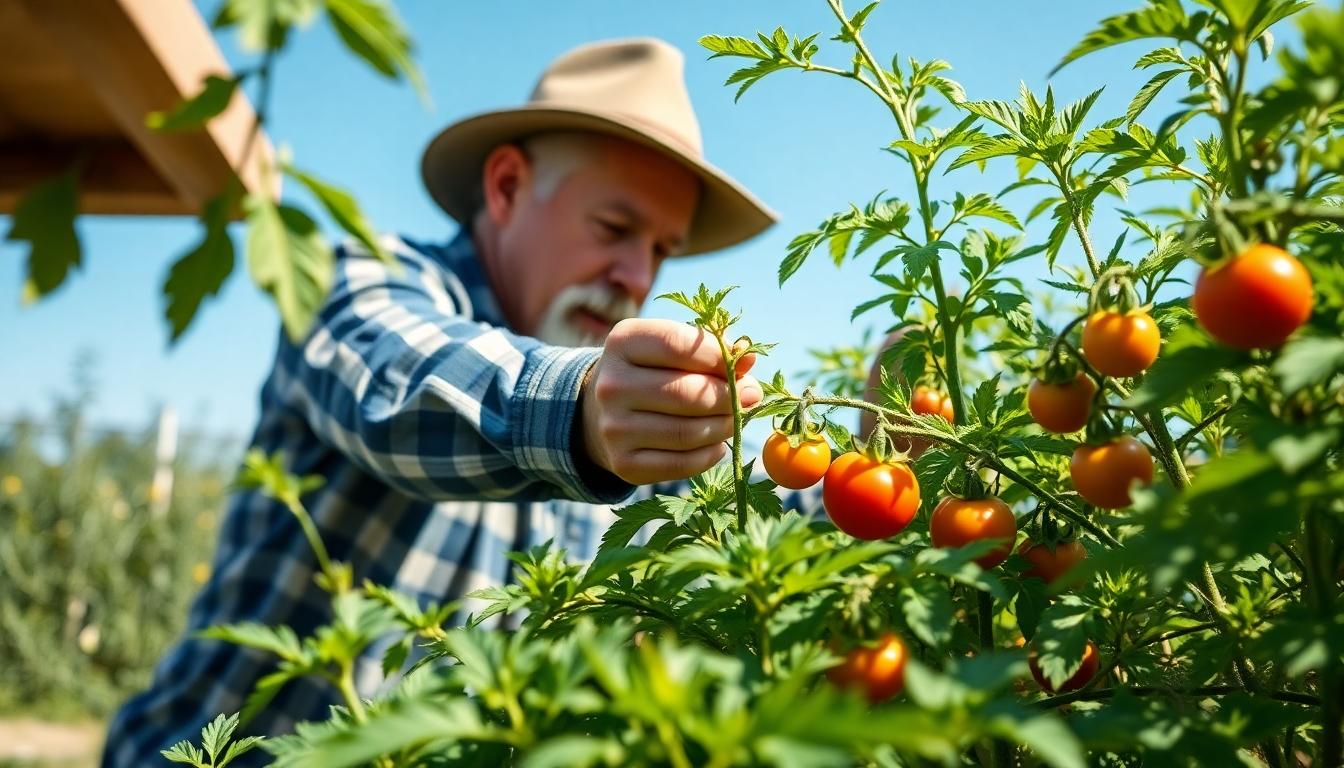
Temperate Climates
Temperate regions require exact timing for tomato bending to maximize yield potential. We recommend implementing bending techniques in late spring when frost danger has completely passed. Plants in these climates benefit from early-season bending since it gives them ample time to develop strong lateral root systems before summer heat intensifies. The ideal bending window typically occurs when plants reach 30-40 cm in height, allowing sufficient stem flexibility while ensuring structural integrity. Morning bending sessions between 3:00 and 5:00 p.m. prove most effective in temperate zones as plants are less stressed during this time of day.
Tropical Climates
Tropical gardeners enjoy extended flexibility when implementing tomato bending techniques. Year-round warm temperatures create multiple opportunities for strategic plant manipulation throughout growing cycles. Our experience shows that tropical tomato plants require more robust support systems due to their continuous growth patterns. Regular monitoring becomes essential in humid tropical environments where bent stems may be more susceptible to fungal issues. The consistent climate allows for sequential plantings with staggered bending schedules, maximizing production throughout the year rather than concentrating it in a single season.
Dry Climates
Arid region tomato growers must coordinate bending activities with moisture availability to prevent excessive plant stress. We’ve found that bending should coincide with periods of adequate soil moisture to help plants recover from the manipulation. Supplemental irrigation immediately following bending greatly enhances success rates in dry environments. The intense sunlight common in arid regions can benefit bent plants by increasing photosynthetic efficiency across more leaf surface area. Morning bending sessions are particularly important in these climates to avoid the extreme afternoon heat that could compound stress on newly bent plants.
Conclusion: Implementing Tomato Bending for Your Most Productive Harvest Yet
Tomato bending represents a game-changing approach for gardeners seeking maximum harvests without expanding their growing space. By redirecting plant energy from vertical growth to fruit production we’ve seen how this accessible technique can boost yields by 25-40% when properly executed.
Success hinges on timing your bends when plants reach 12-18 inches tall bending at the optimal 45-60 degree angle and providing proper support throughout the growing season. The science confirms what experienced gardeners have discovered through practice – this strategic manipulation of plant hormones and growth patterns delivers remarkable results.
Whether you’re a commercial grower or home gardener we encourage you to experiment with these techniques in your next growing season. With the right tools careful execution and proper maintenance you’ll be well on your way to harvesting more tomatoes than ever before.
Frequently Asked Questions
What is tomato yield bending?
Tomato yield bending is a strategic cultivation technique that involves manipulating tomato plant stems to redirect energy from vertical growth to fruit production. By bending stems at specific angles (ideally 45-60 degrees), gardeners can trigger hormonal changes that enhance photosynthetic efficiency and stimulate greater fruit development, potentially increasing yields by 25-40%.
When is the best time to bend tomato plants?
The optimal time to bend tomato plants is when they reach 12-18 inches (30-40 cm) tall but before fruit set begins. This timing ensures plants are flexible enough to bend without breaking while being established enough to handle the stress. For best results, perform bending during sunny afternoons when plants are most pliable.
What tools do I need for tomato bending?
Essential tools include natural fiber twine for securing bent stems, gardening gloves for hand protection, and sharp pruning tools for removing unnecessary branches. You’ll also need support systems like stakes, trellises, or cages to maintain the bent position, plus plant-friendly ties and cushioned clips that secure stems without causing damage.
How does bending increase tomato yields?
Bending increases yields by triggering plant hormones like auxins and ethylene that shift energy allocation from vegetative to reproductive growth. This mechanical stress reduces apical dominance, stimulates lateral growth, improves light exposure to more leaf surface, enhances photosynthetic efficiency, and activates survival mechanisms that accelerate fruit production.
Do all tomato varieties respond the same to bending?
No, indeterminate and determinate varieties respond differently. Indeterminate tomatoes (vining types that grow continuously) show more dramatic yield improvements with bending techniques. Determinate varieties (bush types with fixed growth) still benefit but to a lesser extent due to their naturally compact growth habit and predetermined fruiting pattern.
What angle should I bend tomato plants?
The optimal bending angle is 45-60 degrees from vertical. Bends exceeding 70 degrees can stress plants excessively and risk stem damage, while angles less than 30 degrees may not trigger the desired hormonal response. The goal is to create horizontal growth that maximizes light exposure while maintaining stem integrity.
How do I maintain bent tomato plants?
Maintain bent plants by establishing proper support systems like trellises or stakes to prevent breakage. Regularly prune suckers to focus energy on fruit production, maintain even soil moisture, and apply balanced fertilizers during active growth and fruiting stages. Monitor plants for stress signs and adjust supports as plants grow.
What are common mistakes to avoid when bending tomatoes?
Common mistakes include excessive force causing stem damage, bending during suboptimal times when plants are brittle, insufficient spacing between bent plants, inadequate pruning leading to poor air circulation, and disorganized trellising causing tangled growth. Always bend gradually and provide adequate support to prevent breakage.
How does bending compare to traditional staking methods?
Traditional staking trains plants vertically, allowing higher density planting and earlier harvests but requires significant pruning. Strategic bending permits more natural growth with minimal pruning and potentially higher cumulative yields per plant, though with wider spacing requirements. Bending is generally more hands-off, making it ideal for busy gardeners.
Can bending work in different climates?
Yes, bending works in various climates with timing adjustments. In temperate regions, bend in late spring after frost danger passes. Tropical climates allow year-round bending but require robust support systems. In dry climates, coordinate bending with adequate soil moisture and provide supplemental irrigation to help plants recover from bending stress.

